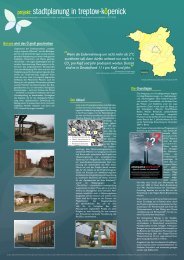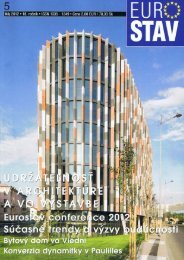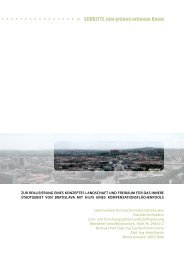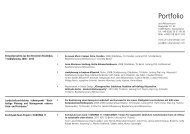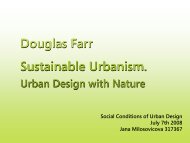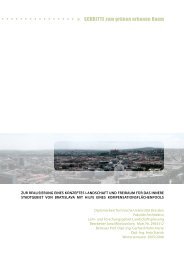Thesis document - Jana Milosovicova - Urban Design English
Thesis document - Jana Milosovicova - Urban Design English
Thesis document - Jana Milosovicova - Urban Design English
- No tags were found...
Create successful ePaper yourself
Turn your PDF publications into a flip-book with our unique Google optimized e-Paper software.
• Passive building air conditioning. Measurements taken at two roofs in Berlin-Tempelhof show that 58% of theradiation balance can be converted into evapotranspiration during summer months. In comparison, non-greenedroofs can convert 95 % of the radiation balance into heat. Façade greening can even more significantly impact on abuilding’s energy balance. The average evapotranspiration rate between July and August was between 5.4 and 11.3millimetres of water per day depending on the respective floor, i. e. an average cooling value of 157 kWh per day.• Green façades. Green façades provide an active solar shading system. As a “side effect”, they illustrate thechanging seasons. Ten types of climbing plants have been planted in 150 planters on nine different buildingfaçades. Façade greening is closely related to the effort of optimising energy efficiency of the building. Plantsprovide shade during summer, while in the winter the sun’s radiation is able to pass through the glass front. Thegreening also harnesses evapotranspiration to improve the microclimate inside and around the building.• Openings in the block for ventilation. The building is not designed as a compact block, but has openings intothe courtyards that allow air circulation and thus a better cooling effect.• Adiabatic cooling systems. During summer months, rainwater is used for air conditioners in the building. For theprocess of adiabatic cooling, rainwater is sprayed on the building’s exhaust air whereby fresh air entering the buildingis cooled through a heat exchanger. This process of air conditioning of a building is effective in cooling incoming airto a temperature of 21–22°C with outside temperatures of even up to 30°C, without having to revert to technicalcooling systems. Evaporation of water is an economic and effective means for the air conditioning of a building. Theevapotranspiration of one cubic meter of water produces an evaporative cooling with a value of 680 kWh. Adiabaticcooling systems can practically be seen as substitutes for conventional air conditioning technologies.The green façades on the southern façade and in one of thecourtyards (Photograph left by Rafael Pizarro; below by Author)Appendices 85



